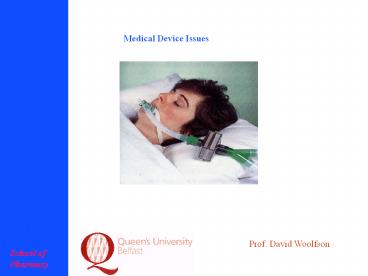Prof. David Woolfson - PowerPoint PPT Presentation
1 / 17
Title:
Prof. David Woolfson
Description:
A device implanted permanently or temporarily in the body for a ... from GORMAN SP et al BRITISH JOURNAL OF UROLOGY. 73 (6): 687-691 1994. School of. Pharmacy ... – PowerPoint PPT presentation
Number of Views:32
Avg rating:3.0/5.0
Title: Prof. David Woolfson
1
Medical Device Issues
Prof. David Woolfson
2
Medical Device A device implanted permanently or
temporarily in the body for a mechanical/structura
l purpose. Usually manufactured by extrusion or
injection-moulding (polymeric devices) Drug
Delivery Device A device intended to deliver a
drug for prophylactic or therapeutic purposes.
Usually, such devices control the rate at which
the drug is made available to the body
(controlled release devices Hybrid device A
medical device with a primary mechanical/structura
l function and a secondary drug delivery
function, either for device protection or
targeted drug delivery.
Devices
3
Device- related problems
- Insertion pain tissue trauma
- Haemocompatibility
- Device encrustation - morbidity
- Device-related Infection - mortality
- gt250,000 device-related infections/year in the UK
cost gt100million due to longer hospitalisation
and more aggressive treatment - There is now substantial interest in bioactive
medical devices that encompass a drug delivery
function
4
Foley urinary catheter
5
- Urinary catheterisation is frequently employed in
clinical and domiciliary care of patients.
Catheterisation may be short or long-term
(indwelling, Foley-type) or intermittent
(Nelaton-type) - Catheter blockage due to encrustation with
complex inorganic salts, resulting in device
failure due to obstruction of flow, remains a
major problem in longer-term use, as does
device-related infection - Tissue trauma due to insertion, and also upon
removal, is a further problem with most types of
catheterisation - Surface formation of microbial biofilm, leading
to UTI
Catheter issues
6
ET TUBES from ICU PATIENTS at (clockwise) 4h, 8h,
12h
Endo- tracheal tube
7
Biofilm formation
Surface of endotracheal tube retrieved from an
ICU patient
8
Ureteral stents
from GORMAN SP et al BRITISH JOURNAL OF UROLOGY
73 (6) 687-691 1994
9
Cardio- vascular stents
angioplasty balloon
mounted stent
stent in situ
Drug-Eluting Stents (stainless steel,
nitinol) The drug-eluting stent is basically a
bare metal stent that is then coated with a
slow-to-moderate-release drug formulation,
sometimes embedded in a polymer. It is hoped that
this will prevent or at least reduce restenosis,
reclosure of the coronary artery, one of the
biggest limitations of angioplasty and causes for
repeat procedures
10
- The rapid evolution of clinical medicine exerts a
continuing demand on manufacturers - Manufacturers with a high cost base must add
value to their lower-end products by making
significant technological advances in order to
compete with commodity suppliers, e.g. in
continence care, respiratory, cardiovascular
sectors - Real clinical improvements are needed to
demonstrate cost-savings to healthcare systems
and justify higher reimbursement costs for
healthcare systems - Manufacturing and design improvements (e.g smooth
device surface) not sufficient - bioactive
devices ultimately required
Medical Devices - economics
11
Medical Devices - polymers
poly(vinyl chloride) plasticised or unplasticised
poly(styrene) crystalline or amorphous (tacticity)
poly(ethylene) HDPE or LDPE
poly(urethane) HDPE or LDPE
silicone repeat unit crosslinked to form an
elastomer
12
Device coatings
- Device coatings can add lubricity,
biocompatibility, and antimicrobial action to
device surfaces. Coatings can be used to release
drugs or make implanted devices more visible to
imaging systems - Many device coatings are hydrophilic
polymer-based formulations, usually hydrogels - Enhanced device lubricity is one major reason for
coating, e.g catheters and guidewires can be
spray coated with a thin layer of
polytetrafluoroethylene (PTFE)
13
- Coatings may be applied to non-polymeric devices
fabricated from stainless steel, platinum or
nitinol (nickel titanium) - Drug delivery coatings that render a device
bioactive are now of major interest.
Typically, a drug in a carrier hydrogel coating
is released as the hydrogel imbibes water from
surrounding biological fluids and swells - Coating technologies presently include
dip-coating, spray-coating, co-extrusion and
chemical grafting to polymers, whereby the drug
is added to the coating mix pre-process - Relevant active agents include non-antibiotic
antimicrobials, antibiotics and inorganic
metallic elements such as silver
Bioactive coatings
14
Controlled release mechanisms
- reservoirs (membranes)
- matrices (monoliths)
- diffusion controlled
- bioerosion/degradation
- pendant chain
- chemically controlled
- osmotic pressure
- swelling
- solvent activated
- externally smart controlled
- e.g. sensor-based
15
Diffusion controlled systems
Matrix (monolithic)
- drug uniformly distributed through polymer
matrix - no danger of drug dumping
- first-order kinetics
- drug core surrounded by non-biodegradable polymer
- properties of drug and polymer govern diffusion
rate - drug-dumping if membrane ruptures
- zero-order kinetics from constant activity
source
Reservoir
16
Effect of bioactive agents released from silicone
Bioactive biomaterials
Miconazole nitrate
Nalidixic acid
Gentamicin sulphate
Ampicillin
Zone of Inhibition (mm)
8
Time (days) of Repeated Microbial Challenge
17
NewLEIF opportunities in bioactive biomaterials
- Alteration of surface topologies
(nano-engineering) - Direct implantation on devices surfaces
(polymeric, metallic) of inorganic elements with
antimicrobial properties, e.g silver , without
the need for coating - Surface implantation on preformed devices of
organic compounds (MW lt 500) with antimicrobial
activity through generation of highly charged
species - Laboratory and clinical assessments of efficacy































